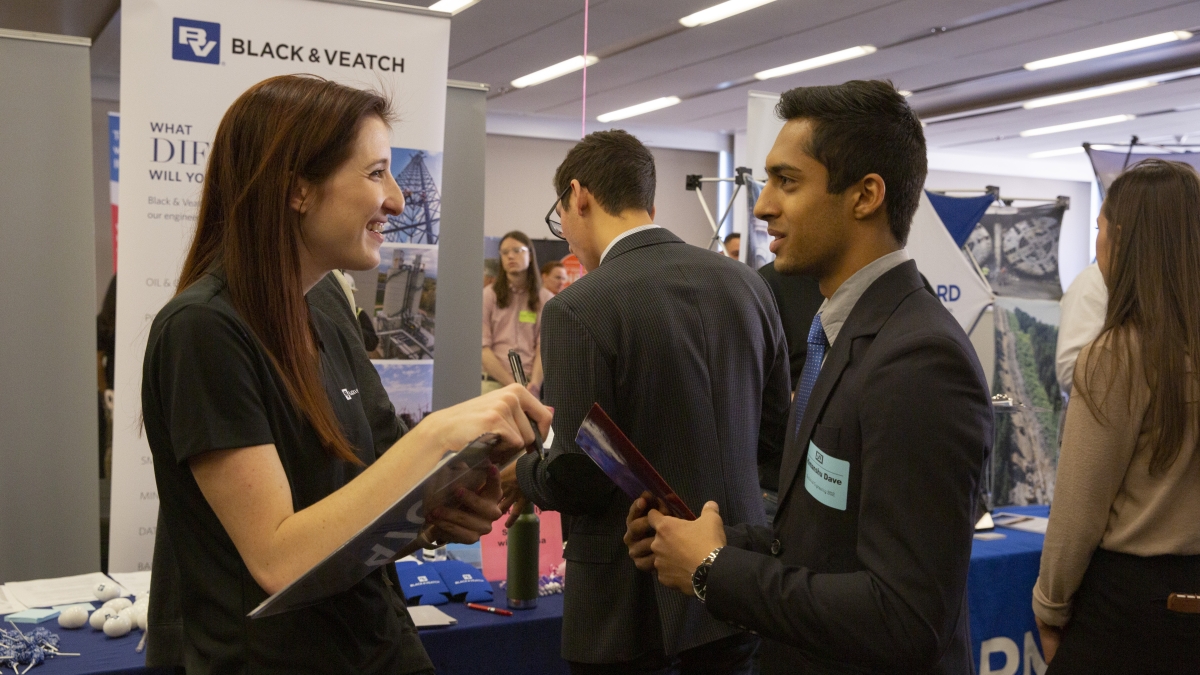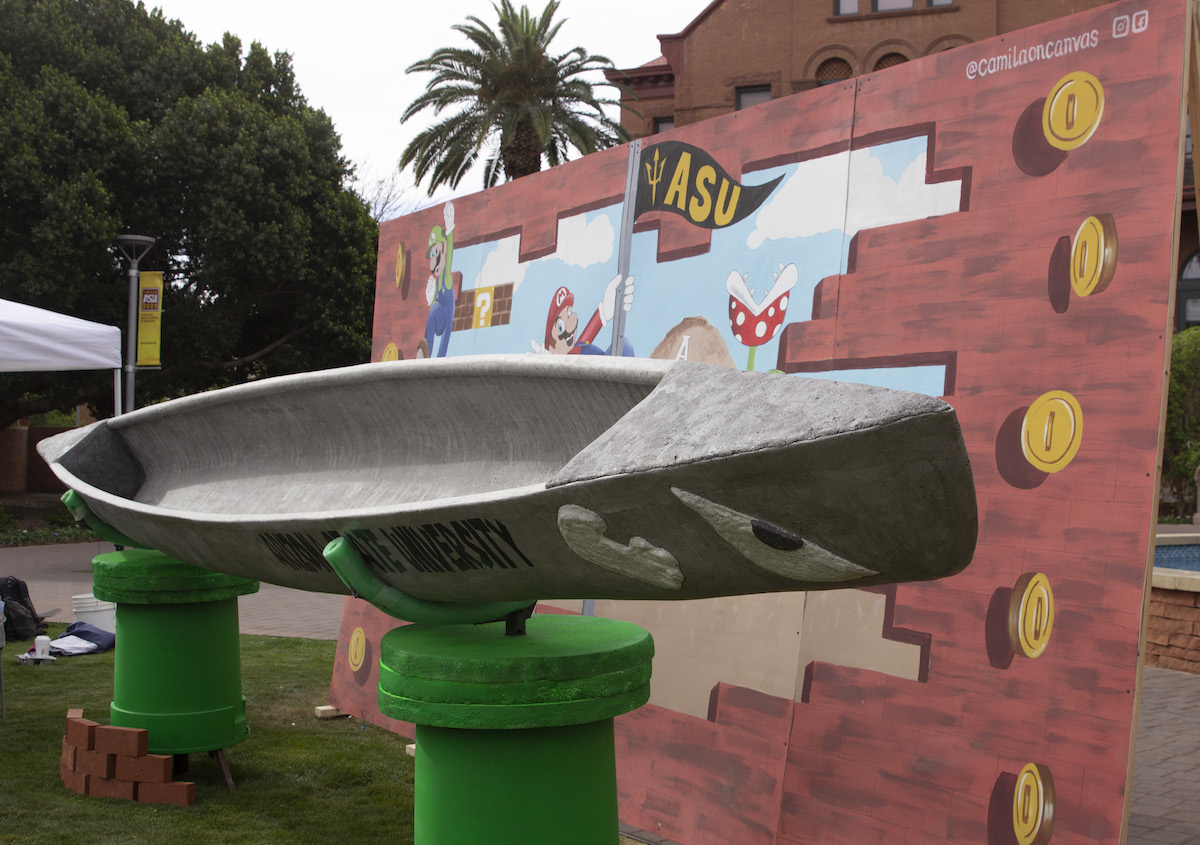Industry and academia link up to prepare future engineers

Arizona State University alumna Olivia Brancati, a civil engineer at Black & Veatch, conducts a brief interview with Himanshu Dave, a mechanical engineering student, at the spring 2019 Fulton Schools Career Fair. Black & Veatch is a member of the Friends of Civil and Environmental Engineering initiative. Photo by Erika Gronek/ASU
The future of our built environment — the human-made physical spaces where we live, work and play — lies in the hands of current civil and environmental engineering students.
From the structural integrity of buildings to the functionality of the transportation system, these structures and the environmental issues they face will require an experienced and skilled workforce capable of developing and sustaining modern communities.
Since the early 2000s, Arizona State University’s Ira A. Fulton Schools of Engineering has been working with industry leaders to educate tomorrow’s civil engineers — and more recently environmental engineers — through the Friends of Civil and Environmental Engineering, or FOCE2, initiative.
Membership donation and participation in FOCE2 enables the school to retain and motivate talented students to achieve success and advance the profession. FOCE2 helps students offset expenses for professional meetings, poster sessions and the Fundamentals of Engineering exam. Students also have the opportunity to interact with industry professionals during career development experiences.
Bruce Larson, the Arizona regional manager and vice president of Bowman Consulting, joined FOCE2 nearly 20 years ago to support and prepare the next generation of civil engineering leaders from the School of Sustainable Engineering and the Built Environment, one of the six Fulton Schools.
“Every civil engineering and environmental firm in the Valley should join FOCE2,” said Larson, who was recently elected as chair of the FOCE2 group. “We owe it to ASU to support the civil, environmental and sustainable engineering program both financially and by providing direction from the industry.”
Educating tomorrow’s civil and environmental engineers
FOCE2 members make it possible for civil and environmental engineering students to find internships and permanent employment upon graduation. They improve the curriculum, host guest lectures, teach skill-building workshops, attend career fairs and plan social mixers with industry. These opportunities enable students to develop soft skills for the workforce that aren’t always taught in the classroom.
Additionally, FOCE2 offers students funding for worthwhile purposes such as attending the American Society of Civil Engineers Pacific Southwest Conference and participating in ASU’s Engineers Without Borders chapter.
In 2018, ASU partnered with Northern Arizona University to co-host the American Society of Civil Engineers Pacific Southwest Conference in Tempe, Arizona. The three-day conference brought more than 1,800 attendees from 18 universities to compete in 30 competitions.
Emily Ford, ASU’s co-chair for the 2018 Pacific Southwest Conference, wanted to utilize the local Tempe Town Lake for the concrete canoe races — one of the biggest and most famous of the ASCE competitions. However, the student planning committee didn’t have the funds to reserve the lake for a day.
“FOCE2 funding was essential for reserving our venue and putting on one of the most highly anticipated competitions of the conference,” said Ford, a civil, environmental and sustainable engineering doctoral student in the Fulton Schools. “Without their support, we may not have been able to reserve Tempe Town Lake for the concrete canoe races.”
Ford relied on a New University President’s Scholarship to fund her undergraduate education and a Dean’s Fellowship to fund her graduate education. She says the philanthropy students receive is helpful to be able to afford life-changing academic and extracurricular experiences at ASU.
“I had never heard of FOCE2,” said Ford. “Once I learned there was a panel of local industry professionals who met and placed input into our studies, I was impressed. It makes sense to confer with our future employers about what they want from their future workers, and it gives our degrees greater value because we should be learning the skills most needed in industry.”
FOCE2 also provided funding for ASU’s Engineers Without Borders chapter. The chapter partners with developing communities to help improve their quality of life by implementing economically and environmentally sustainable engineering projects.
Under the mentorship of Regents' Professor and Ira A. Fulton Professor of geotechnical engineering Edward Kavazanjian, a team of six students traveled to Pune, India, to assess water shortages and water contamination in surrounding rural villages.
The purpose of the trip was to collect data and create ties with the community so the team of students could spend the next academic year designing and developing a water system to improve the village's access to clean water.
“The financial aid FOCE2 provided was extremely helpful. Without funds, it’s impossible to get any project out of the planning phase,” said Allen Crowder, a former engineering student who switched his major to European history and graduated in 2018. “This kind of philanthropy also gives aid to communities in need.”
Crowder says FOCE2 and Engineers Without Borders share common values and goals. Each one gives students the opportunity to put classroom learning into practice and gain experience with project planning, documentation, fundraising and implementation.
“Ninety percent of what we do isn’t taught in classes — engineering or otherwise — which is why it’s so important for students to do extracurriculars like these,” said Crowder. “Collaboration and support between humanitarian and philanthropic organizations can do good for all parties. I hope this tradition continues, and I strongly encourage students of any major to take advantage of these opportunities.”

A concrete canoe on display at the 2018 American Society of Civil Engineers Pacific Southwest Conference, which was co-hosted by Arizona State University and Northern Arizona University in Tempe, Arizona. FOCE2 funding helped students in the planning committee reserve Tempe Town Lake for the concrete canoe races — one of the biggest and most famous ASCE competitions. Photo by Erika Gronek/ASU
Braving the storm to improve our built environment
Thomas G. Schmitt, president of the local construction management company T & S Diversified Inc., started the initiative as the Friends of Civil Engineering with the help of Fulton Schools Professor Sandra Houston, who served as chair of civil and environmental engineering between 1996 and 2006. Schmitt served as the chair of Friends of Civil Engineering for over 10 years and was recently inducted into the school’s hall of fame.
The Great Recession of the late 2000s and early 2010s devastated the civil engineering profession and nearly pushed FOCE2 to extinction. When President's Professor Keith Hjelmstad took over as chair of the civil engineering program, he pushed FOCE2 to take on a broader role in its interaction with the university, and he led the transition to a new vision and structure of the organization.
“It is vital for our program to have a strong connection with the professional community,” said Hjelmstad. “FOCE2 is our primary connection to the industry. I really think of this group as the ‘brain trust’ we need to ensure our students are the top candidates for the civil and environmental engineering workforce.”
In April 2015, Ron Hilgart took over as chair of the FOCE2 steering committee. Hilgart is the founder and managing principal of HILGARTWILSON, an Arizona-based civil engineering consulting firm. Under his leadership, the new vision of FOCE2 became a reality. He led the efforts to engage younger engineers from member firms through committee activities, creating a route for FOCE2 to develop new leaders.
With Hilgart’s guidance, FOCE2 has been able to give students more opportunity to interact with industry professionals through resume workshops, internship opportunities, career fairs and social mixers.
“Ron was instrumental in forwarding and expanding the role of FOCE2,” said Larson. “When he took over as chair, we were mainly operating as a committee to bring in memberships and provide money to the civil and environmental engineering programs. He successfully brought in additional committees for education, internships, employment and more to help partner civil engineering industry professionals with ASU.”
Hilgart and Larson, the membership subcommittee chair at the time, utilized their combined experience in civil engineering and leadership to reach out to other professionals in the community and encourage them to join FOCE2. Their efforts helped double membership over the past couple of years.
“It’s our responsibility to give back to our local university,” said Larson. “The partnering between ASU and the civil and environmental engineering industry allows us to provide input and direction from practice to aid the university in providing the best and most applicable education for its students.”
Learning from the past to improve the present
FOCE2 chair Larson and Frederick Tack, the recently elected vice chair, are ready to continue building on the initiative’s long-standing success and invaluable impact on civil and environmental engineering students in the Fulton Schools.
Larson, a fourth-generation Arizona native, started working for his father’s engineering firm when he was a teenager. After completing a bachelor’s degree in civil engineering at Brigham Young University, he progressed to senior and executive-level roles at RBF Consulting, Michael Baker International and Westland Resources. More recently, he became the Arizona region manager and vice president at Bowman Consulting, a civil engineering company with five offices in Arizona and northern Mexico.
Larson brings a unique perspective to FOCE2 since he comes from the private industry and has served on other nonprofit boards.
Tack currently serves as an associate and service group manager at GHD, a leading engineering, architecture and environmental consulting company. He leads a multidisciplinary team of engineers, operators and technicians in delivering and operating water and wastewater treatment infrastructure.
Tack brings more than 18 years of industry experience to FOCE2. Additionally, he’s an alumnus of ASU's civil engineering program who practiced and applied concepts learned at the university to develop character and leadership skills that were critical to his success in the industry.
“Participation in FOCE2 provides me a conduit to give back to the next generation of civil and environmental engineers and have a voice in recommendations to the departments to understand industry needs and direction,” said Tack. “There is no better opportunity to have a direct impact on today’s education of engineers and gain access to the best and brightest graduates for my hiring needs.”
For the future of FOCE2, Larson and Tack want to find better ways to engage busy professionals. Larson says many firms become members to financially support students but never become fully engaged. The lack of engagement results in low retention rates and hinders the collection of meaningful input and direction.
The new chair and vice chair plan to continue expanding membership to increase funding for the civil, environmental and sustainable engineering program, but also find ways for new members to enhance students’ knowledge of the industry. Larson also sees the industry and academia partnership as an essential component in the advancement of future civil engineers and the profession as a whole.
“It’s an honor to be chosen as the new chair of FOCE2,” said Larson. “I’m excited to work with the vice chair, the steering committee, ASU and member firms to better support and improve the civil and environmental engineering program at ASU.”
More Science and technology

ASU professor honored with prestigious award for being a cybersecurity trailblazer
At first, he thought it was a drill.On Sept. 11, 2001, Gail-Joon Ahn sat in a conference room in Fort Meade, Maryland.…

Training stellar students to secure semiconductors
In the wetlands of King’s Bay, Georgia, the sail of a nuclear-powered Trident II Submarine laden with sophisticated computer…

ASU startup Crystal Sonic wins Natcast pitch competition
Crystal Sonic, an Arizona State University startup, won first place and $25,000 at the 2024 Natcast Startup Pitch Competition at…